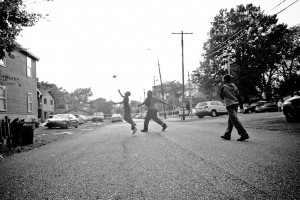Are We Taking Play Seriously?
There is nothing frivolous about children’s play.
It is so important that the United Nations High Commissioner for Human Rights recognizes “the right of the child to rest and leisure, to engage in play and recreational activities appropriate to the age of the child and to participate freely in cultural life and the arts.” Apparently, the media, moms, doctors and scientists also share that view (and did you know that there is even an American Journal of Play?). Athletics and other organized sports are invaluable for children. We can also agree that increasing the amount of time our kids spend actively and freely playing is good for their physical and mental health, development and independence. Yet despite these benefits, free play among U.S. children has dropped significantly in recent decades.
It’s tempting to blame this decline in free play solely on “the seductive qualities of television and, more recently, computer games and Internet activities,”[1] but we also know that parents are often fearful of sending kids outside to play without supervision. Remember hearing, “go play outside and come home when the streetlights come on?” I heard that as a kid growing up in the suburbs. Whether or not we had that experience, it’s no more than nostalgia now. Justified or not, we have developed a heightened sense of “stranger danger,” and many families face threats to their children’s safety near their homes, like high-speed traffic, drug deals within view, gang violence and the fear of police harassment, particularly in low-income communities of color.
To improve opportunities for safe play, I suggest looking at places where children (and families) spend their time outside the home.
- Our communities are a collection of public and private spaces that hinder or encourage safe play. Parents and children are best able to point out the neighborhood hotspots, opportunities and potential solutions. The Healthi Kids Coalition, in Rochester, NY, which happens to host the National Museum of Play, takes children’s play so seriously that they consider it to be a critical indicator of their community’s health and vitality. The Coalition created and implemented an innovative solution-based mapping and engagement process that developed Playability Plans in five urban neighborhoods. Check out their video story and learn about their practical efforts to address neighborhood safety concerns.
- Child care settings can create the right conditions for active play. Even small encouragements make a difference. For example, a simple “policy” in which centers require parents to leave their children’s winter coats, hats and mittens at drop-off time means that everyone is suited to play outside, even when it’s cold. Child care providers can seek specific guidance and set their own goals for physical activity and healthy eating using NAP SACC (Nutrition And Physical Activity Self Assessment for Child Care), a planning tool that’s helped thousands of centers become more active spaces.
- Planners, architects, landscapers, engineers and builders should think intentionally and creatively about how children will interact in the spaces and buildings they construct. In my town, Pittsboro, NC, park planners complement the use of natural materials with novel play structures. In fact, new national guidelines for active play spaces, “Nature Play & Learning Places,” were just released by Robin Moore, a longtime educator, architect and advocate for children’s health and learning.

For all of these efforts, safety should be top of mind: families will stay home if parents don’t feel comfortable. Admittedly, what constitutes a safe and active play space for children is in the eye of the beholder, and consensus on what’s best can be hard to come by. For example, when my ALBD colleague, Fay Gibson, recently blogged about the lack of safety on the streets of disadvantaged communities, we reacted very differently to the same image, shown left. I felt nostalgic when I saw the photo because I grew up playing ball in the street in front of my house in the suburbs. I remembered summertime and fun with friends. But Fay recalls a different experience, as described in her blog, of young people’s routine exposure to violence within their own neighborhoods. That exposure, Fay explains, is not limited to the past. I recognize that the privilege I had to enjoy my youth without constant danger is not something that all families share.
Fay calls on us to act for total health for all. I agree and hope that we include safe play as an indicator of total health in communities, parks and child care centers, whether they are in middle-class suburbs or low-income urban neighborhoods.
[1] American Journal of Play, Volume 3, Number 4. © 2011 by The Strong. Contact Peter Gray at grayp@bc.edu. Accessed at http://www.journalofplay.org/sites/www.journalofplay.org/files/pdf-articles/3-4-article-gray-decline-of-play.pdf